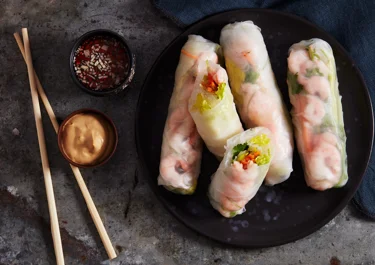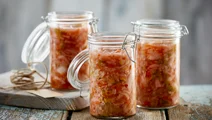Vietnamese spring rolls

Take a fun cooking adventure straight to Vietnam with our Vietnamese spring rolls. Delicate rice paper envelops glass noodles, crisp vegetables, and prawns, served with not one but two equally delicious dipping sauces. One is creamy with soy; the other zesty with lime, fish sauce, and a touch of chilli. Time to roll up your sleeves and start wrapping!
Ingredients
Spring rolls
|
Glass noodles
|
50 g |
|---|---|
|
Rice paper
|
12 sheets |
|
Carrot
|
1 |
|
Leek
|
½ |
|
Cucumber
|
½ |
|
Prawns, peeled
|
100 g |
|
Fresh coriander, chopped
|
2 tbsp |
Sauces
|
Sour cream
|
100 ml |
|---|---|
|
Chinese soya sauce
|
1 tbsp |
|
Red chilli
|
1 |
|
Garlic clove
|
1 |
|
Icing sugar
|
2 tbsp |
|
Fish sauce
|
50 ml |
|
Lime fruits, juiced
|
2 |
Instructions
Spring rolls
Sauces
Recommended information
Serving suggestion
Avoid sticky rice paper
To prevent rice paper from sticking, be mindful of how long you soften it. Dip it in warm water for a few seconds because soaking too long makes it overly soft and difficult to handle. Add the fillings right away and roll immediately. Once rolled, keep the spring rolls separate to stop them from sticking. Avoid stacking them on top of each other, and if needed, wrap each roll individually in cling film.
Organise before rolling
Rolling Vietnamese spring rolls is much easier when everything is prepped and ready to go. Cook the glass noodles, let them cool, and shred the carrot, leek, and cucumber. Clean the prawns and lay everything out within reach. If you are making them with friends or family, set everything in the middle of the table so everyone can quickly assemble their own. This prevents the rice paper from becoming too sticky or drying out while rolling.
Mastering the rolling technique
Start by placing the fillings slightly below the centre of the rice paper, closer to you. Fold the bottom edge over the fillings and gently pull it back to tuck everything snugly. Fold in the sides, then roll forward, keeping it firm but not too tight to avoid tearing the rice paper.
FAQ: Questions about Vietnamese spring rolls
Are you unsure how to keep your Vietnamese spring rolls fresh or stop the rice paper from tearing? We have answered the most frequently asked questions to make things easier.
What is the best way to prevent rice paper wrappers from tearing?
The best way to keep rice paper from tearing is to briefly dip it in warm water so it softens without becoming too fragile. Place it on a smooth, non-porous surface like a plastic cutting board or ceramic plate, as wooden boards can absorb moisture and cause sticking. When rolling, do not overfill it, and handle the rice paper with a firm but gentle touch. Fold the bottom edge over first, tuck in the sides, and roll tightly but carefully to keep everything intact.
What are Vietnamese spring rolls?
Vietnamese spring rolls, also called gỏi cuốn in Vietnam, are light and delicate rolls wrapped in rice paper. Inside, you will find a mix of crisp vegetables, fragrant herbs, rice noodles, and prawns, sometimes paired with pork. They are always served with a dipping sauce, which varies by region and preference. In southern Vietnam, a hoisin and peanut-based sauce is popular, while in central and northern Vietnam, a tangy fish sauce dip is more common.
Can Vietnamese spring rolls be prepared in advance?
Yes, Vietnamese spring rolls can be made a few hours before serving, but they are best enjoyed fresh. Wrap each roll individually in cling film to keep them soft and prevent sticking, then store them in the fridge. Before serving, let them sit at room temperature for a few minutes to soften if needed.
What is the best rice paper for making spring rolls?
The best rice paper for spring rolls is thin to medium thickness, so it stays flexible and easy to roll without tearing. It also comes in different sizes; larger sheets are great for full-sized rolls, while smaller ones work well for bite-sized versions. So, pick the size that suits your serving style and appetite.
How do I store leftover Vietnamese spring rolls?
Store your leftover Vietnamese spring rolls in the fridge and eat within 24 hours. Wrap each roll individually in cling film and place them in an airtight container. We do not recommend freezing the spring rolls, as the rice paper becomes brittle and rubbery once thawed.
Nutritional values
Nutritional value, per
1032 Kcal
| Fibre | 5 gram fibers |
| Protein | 26.2 gram |
| Carbohydrates | 191.1 gram |
| Fat | 16.9 gram |
Make fresh Vietnamese spring rolls
Get rolling with these fresh Vietnamese spring rolls! You can make them solo or turn them into a DIY experience with friends and family, letting everyone decide exactly how much to tuck inside the rice paper. The rice paper itself may feel delicate, but it is sturdier than it looks and ready to hold everything snugly inside. So, set up your workspace, start rolling, and enjoy the process.
If you love the freshness of these spring rolls, you will also enjoy our green goddess salad, colourful sushi bowl, and silky-smooth mango lassi for more light and refreshing meals.
Filled with crisp vegetables and delicate prawns
While the rolling is fun, the real reward comes from biting into the delicious filling. Carrots snap with a little sweetness, cucumber keeps things cool and refreshing, and leek provides a mild sharpness. These crisp veggies are exciting to bite into, but they do need a little balance. So, let the prawns shine and give you the soft texture and delicate sweetness they are famous for.
With two aromatic dipping sauces
Double the dip, double the flavour! The first of the dipping sauces is a simple yet full-flavoured blend of soy and sour cream. The salty, umami backbone of soy is tempered by the velvety tang of sour cream.
The second, a classic Vietnamese nước chấm, presents a pungent combination of sweet, salty, and spicy notes. Rich, umami fish sauce meets the sharp tang of lime, softened by a gentle sweetness from the icing sugar, all punctuated by the fiery sharpness of red chilli and garlic.
One is thick and comforting, clinging to every roll for a creamy, full-bodied bite. The other is an intense liquid sauce you can really sink your rolls into if you enjoy this dipping sauce, which we imagine you will.
Enjoy a classic meal from Vietnam
Vietnamese spring rolls are a culinary cornerstone throughout Vietnam, found everywhere, from bustling street markets to home-cooked family meals. Vendors roll them fresh to order, tucking crisp vegetables, prawns, and herbs into delicate rice paper before handing them over to be enjoyed on the go. At home, they are often part of a shared meal, where everyone gathers around the table to roll their own.
Now, you can replicate that exact experience in your own kitchen. With a few simple steps, you will have a spread ready for rolling and dipping, mirroring the cherished dining traditions of Vietnam.
Take the dish in new directions
Our recipe for Vietnamese spring rolls offers endless possibilities, and we have a few suggestions to help you customise them to your taste. Swap the prawns for grilled chicken, which offers savoury, slightly smoky notes, or pork, which provides a mildly sweet flavour and mouthwatering juiciness.
For more veggies, try bean sprouts with their earthy flavour and pleasant crunch. Avocado works wonders, too, contributing a nutty and buttery consistency. A few sprigs of mint give the rolls a refreshing element with their cooling and herbal touch.









